Apple's QuickTime Plugin is required to view these movies. If you do not already have QuickTime installed, you can obtain the latest version at http://www.apple.com/quicktime/.
MBL Pivot Movie Demo
A key challenge is how to deliver massive image collections such as the MBL, Allen Brain Atlas projects, and BrainMaps using modern web services. In this work we tested Microsoft Live Labs Pivot (www.getpivot.com) as an image distribution portal. Pivot provides a unique method for delivering and exploring very large collections of high-resolution images.
If you would like to experiment with Pivot collection in your preference browser, Microsoft Silverlight is required. MBL pivot collection is available here.
|
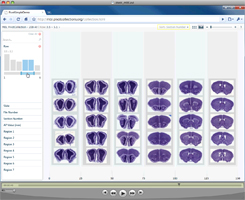
|
Cell Identification Movie (1.0 MB)
This through-focus movie of the dorsal lateral geniculate nucleus demonstrates our procedures for cell counting and identification. This movie was created from a portion of the hi-res through-focus movie below. Abbreviations:
- E: Endothelial Cell
- G: Glial Cell
- I: Interneuron
- N: Principal Neuron
- U: Unclassified Cell
|
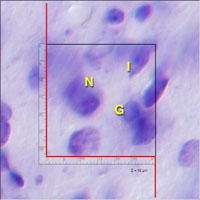
|
High Resolution Through-Focus Movie
A through-focus series of the thalamus (36 frames through the dorsal lateral geniculate nucleus) cut in the coronal plane. This is just a very small central piece of the whole field. The material is from a BXD5 female (celloidin ID 241, slide A, section 23 left, case ID 072397A). The tissue was imaged with a 40X oil objective (Olympus UVFL NA 1.3) used in combination with DIC optics. Pixel resolution in the XY plane is 0.09 µm/pixel (optic resolution approximatley 0.3 µm and the field is 275 x 183 µm. The Z axis step averages 1.0 µm. The image stack was acquired manually over a 5 minute interval using the PhaseOne digital camera back (3056 by 2032 pixels, 8-bit color). You will need a QuickTime plug-in to step through the sections. Make sure your browser has plenty of memory. Two smaller preview movies are also available:
- Small zoomed-in sample from the center of the full field that demonstrates the maximum resolution of the large image stack (0.4 MB).
- Smaller down-sampled version of the original that shows the entire field. (0.9 MB).
- High Resolution Through-Focus Movie. CAUTION: 23.8 MB! Download this file to disk and then play locally using the QuickTime player. This is the whole field at its original capture resolution. You will need a large monitor to view the field at even a 50% reduction. The best way to view the z axis stack is to select "full screen" in the QuickTime Player after you have opened the file. For improved performance, assign QuickTime ample memory.
|
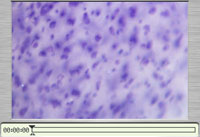
|
|
Mouse Brain Fly-Through Movie (0.9 MB): Sections of a brain cut in the horizontal plane (C57BL/6J). Resolution is 24.5 µm/pixel. Sections are spaced 150 µm apart. You will need a QuickTime plug-in to step through the sections. Make sure your browser has plenty of memory. A smaller (0.2 MB) preview movie is also available:
|
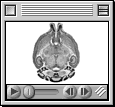
|
|
Mouse Brain Stack Movie (1.0 MB): In this version, the sections stack on top of each other from ventral to dorsal. A smaller (0.2 MB) preview movie is also available.
|

|
|
3D Atlas of a Mouse Brain (2.2 MB): We stained and photographed every horizontal section of case 020 from the MBL (a 129/SvJ, 39-day-old male with a 386 mg brain). Dr. Nissanov and colleagues at Drexel/MCP Hahnemann University used these images to construct a complete 3D digital representation of the brain at a resolution of approximately 30 µm in all axes (i.e., an isotropic 3D atlas). This 3D model is like a super-high resolution MRI and can be digitally sectioned in any axis. Here we show a fly-through of the brain in the frontal axis, at right angle to the sectioning plane. High-resolution color images of whole mouse brains are also available.
|
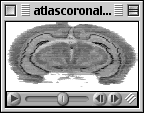
|
|
High Magnification Movie (0.4 MB): A through-focus series of the hilus region of the dentate gyrus. This movie illustrates some features of the direct 3-dimensional counting method. Step through the movie frame-by-frame. Each frame is separated by 1 µm in the z axis. The scale bar is divided into 2-µm units.
|

|
|
MRI Fly-Through of a Mouse Head and Brain in the Frontal Plane. This QuickTime movie was generated from a 62.5 micron/pixel isotrophic scan of a female BXD5-Ty mouse by E. Ahrens, R. Jacobs, and R. W. Williams (1996 unpublished) taken with the 12 Tesla Caltech system. Each frame is 200 by 200 pixels.
|
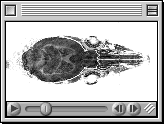
|
